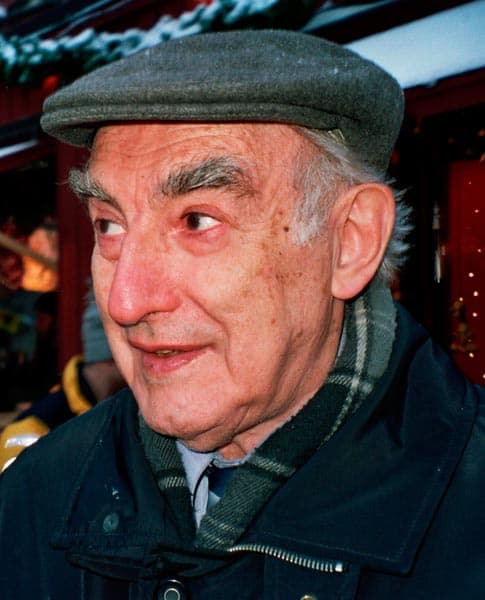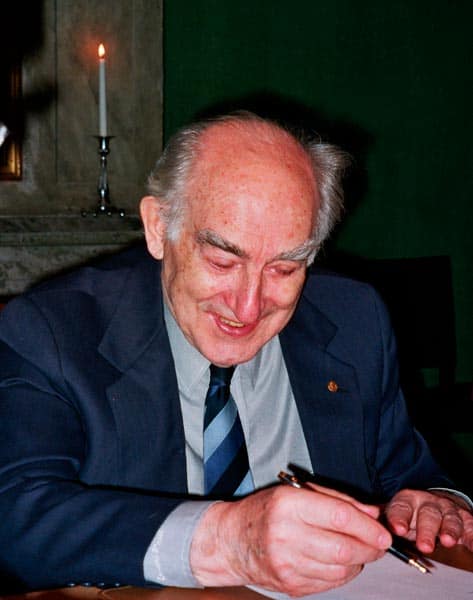Vitaly Ginzburg, who turned 93 last month, is one of the most prominent Russian theoretical physicists of the 20th century and shared the 2003 Nobel Prize for Physics with Alexei Abrikosov and Tony Leggett for their work on the theory of superconductors and superfluids. In an exclusive interview with physicsworld.com, Ginzburg talks to Matin Durrani about how his interest in physics developed, why he distrusts the church’s growing role in Russian society, and how his role in developing a hydrogen bomb for the Soviet Union saved his life.

Physics World: How did you first become interested in physics?
Vitaly Ginzburg: I was sent to school in 1927 when I was 11. Education was not compulsory at the time, which meant that I started in the fourth form. But in 1931, after I had been at school for only four years, the Soviet Union imposed another round of idiotic school reforms, abolishing all upper secondary schools, which used to be for 16–18-year-olds. It was recommended that all pupils who had been at school for seven years should transfer to the factory school (the school for “working people”) and that only then should they try to find a way to enrol in a university.
But I did not like this path and went to work as a technician in the X-ray laboratory of one of the higher-education technical institutes, where I was first introduced to physics. I was especially impressed with a popular-science book by the Russian physicist Orest Danilovich Hvolvson entitled Physics in Our Day. It was then that I decided to become a physicist and I began to familiarize myself with the knowledge necessary for admission to university, which had just been made a competitive process. Not without difficulties, I became a student of the physics department of Moscow State University (MSU) in 1933 on the second course.
Who or what had the biggest influence on you in the way you think about and approach physics?
I think that my biggest achievement in physics is connected with the theory of superconductivity.
Hvolvson’s book deserves another mention, though I never actually met the author in person. Then there were university textbooks such as The Fundamentals of the Theory of Electricity by Igor Tamm (the famous course of Lev Landau and Evgeny Lifschitz had not yet been written). I was also influenced by Leonid I Mandelstam, who was a very prominent figure at that time. Now we have many good books on physics and the latest results are described in review journals, such as Uspekhi Fizicheskikh Nauk [Physics–Uspekhi], which has been published since 1918 and of which I have been editor-in-chief for over 11 years.
Looking back on your scientific career, what do you think has been your single biggest achievement in physics, and why?
To me, the special charm and specific feature of theoretical physics is that you can quickly change what you are studying. Typically, you do not need many years to build new equipment, as experimentalists often do. In this spirit, I worked in many areas of physics and astrophysics. The main highlights of my work are described in my recently published book On Superconductivity and Superfluidity (Springer, 2008) in the chapter called “Scientific Autobiography. An attempt.” Having said all that, I think that my biggest achievement in physics is connected with the theory of superconductivity.

Do you have any regrets about your part in developing the hydrogen bomb for the Soviet Union?
We thought at the time that we were working to prevent a monopoly on the atomic bomb – Hitler’s monopoly if he got the bomb before Stalin. The thought of what would happen if Stalin had a monopoly on atomic weapons somehow never entered my head. Scary thought. Stalin would seek to subjugate the entire world. I admit this may betray stupidity, but this stupidity was, back then, a common way of thinking in the Soviet Union.
I wish to use this opportunity to clarify my input into the creation of the Soviet Union’s hydrogen bomb. In 1948 it was already clear that the Soviet Union would acquire nuclear weapons and would be able to compete with the US. In addition, secret sources revealed that the Americans were starting to think about building an H-bomb and so a group of Soviet theorists were instructed to address this issue, although not in a particularly urgent way as the problem was not yet being treated as a high priority. Before 1948 I had no connection with atomic weapons work, but once it had been decided to race the US for the H-bomb, Tamm was brought in and asked to suggest people to join such a team. I was his deputy in the theory department of the Lebedev Physical Institute so, naturally, Tamm proposed including me. However, as I learned many years later, my candidature was initially rejected; it was approved only some time later.
Why were you initially turned down from being part of the H-bomb team?
The main point was that I was not treated as a “reliable person” by the Soviet authorities: for example, my wife was in exile. But when the problem began to be treated seriously, I was included in the team due to the fact that I had, as one would say nowadays, a high scientific rating. Incidentally, Andrei Sakharov was included in the team at the request of our director, Sergey Vavilov, because Sakharov and his wife had a small child but did not have anywhere to live; after joining the group the Sakharovs were assigned a single small room in a communal flat.
I am a very rare – and possibly unique – person in that I was saved by the H-bomb!
One way or another, we began to get acquainted with the available materials and concluded that they offered no real guidance for the design of the H-bomb. At this stage Sakharov and I advanced two ideas that could solve the problem. In his memoirs, Sakharov called these ideas “the first” and “the second”, because they were still classified. His “first” idea was to use alternating layers of uranium and fuel, while my “second” was to use lithium-6 as a fuel, which would, when hit by neutrons, create tritium and helium nuclei and liberate 4 MeV of energy per nucleus. I do not think that either of these ideas was terribly bright, but together they made it possible to create the H-bomb.
What happened next?
Once the authorities had decided to build the H-bomb based on these two ideas, the real work was transferred to Arzamas-16 (the city of Sarov) where the main atomic bomb laboratories were situated. But at this stage I was once again refused clearance for the work and stayed in Moscow. I started working on the thermonuclear energy problem but at the end of 1951 I lost clearance for that work too. That was the end of my “top secret work”, period. It was a time of terror. Stalin personally signed orders for 40,000 people to be executed by firing squad. I have no idea why I missed one of those execution lists. I think that I was a very good candidate for this fate: my wife was in exile and I was branded by some as Bezrodny Kosmopolit [“homeless, stateless cosmopolitan”]. Of course, my Jewish origin could also be an “argument”. Suffice to say that I was expelled from the scientific council of the Lebedev Institute, seemingly in an attempt to make it stronger. But why I was not on the firing squad list at that time I still do not know. Perhaps it was sheer luck. Maybe an unknown somebody had expressed a kind of gratitude for the “second idea”. The bottom line is that I am a very rare – and possibly unique – person in that I was saved by the H-bomb!
You have long been a staunch atheist: what are your concerns about the growing influence of the church in Russian public life?
I am, and always have been, an atheist, but I think that to be – or not to be – religious is a fundamental human right.
I am, and always have been, an atheist, but I think that to be – or not to be – religious is a fundamental human right. It is, however, a different matter if the church interferes with secular education, offering creationism as a foundation of science (in other words, the idea that God created everything and that everything then evolved obeying laws that were also established by the divine powers). I fully reject this approach and therefore keep seeking to expose creationism as false. This struggle is not easy because church leaders try to equate belief in God with a struggle for high moral values and, among other things, a struggle against alcoholism. It is clear that when the church is fighting alcoholism, or drug abuse, or immoral behaviour, I am certainly not against it. But I am convinced that the bright future of mankind is connected with the progress of science and I believe it is inevitable that one day religions (at least those existing now) will drop in status to no higher than that of astrology. When that will happen is, of course, is difficult to say.

What do you think are the three most important unsolved problems in physics?
Regarding the current state of physics as a whole, it is possible to divide it into two parts: “modern physics” (ordinary physics) and “the physics of the future” (extraordinary physics). Modern physics covers everything that we know and also what we do not yet know (but, in principle, can learn) in close vicinity to the data that can be obtained at the Large Hadron Collider at CERN; this is partly true for cosmology too. I also include condensed-matter physics and plasma physics as part of modern physics, the main task of which is to create substances with special properties that we wish to have. Currently, not all possible combinations can be calculated, let alone implemented. One example of such a task is to create room-temperature superconductors, which appears to be a problem that can be solved but one that remains stubbornly beyond our reach.
As for what I call extraordinary physics, there we encounter problems involving fundamental uncertainties. This includes the question of what types of particles can exist. With regard to cosmology, I hold a perhaps unorthodox view that the complete theory should not have singularities, in particular no energy density singularities. This not fully understood area of cosmology is characterized by the Planck length [1.616 × 10–35 m] and Planck time [5.4 × 10–44 s] I once tried to work in this direction but obtained no very significant results – see, for example, my 1971 paper in the Soviet Journal of Experimental and Theoretical Physics (33 242). In general, it is a huge terra incognita.
Of course, I feel it would be logical to include the problems of creation of life and the emergence of logical thinking in “future physics”, although it is perhaps “extraordinary biology” rather than physics. It is impossible to know when success will be achieved in “extraordinary physics” but it may happen in the coming years.
Finally: when and where were you happiest (if such a state of mind exists)?
You do feel happier when you produce results. However, I would not really say that one’s previous achievements make one happy.
• This interview was translated from the original Russian by Vitaly Kisin. With thanks to Maria Aksenteva.



